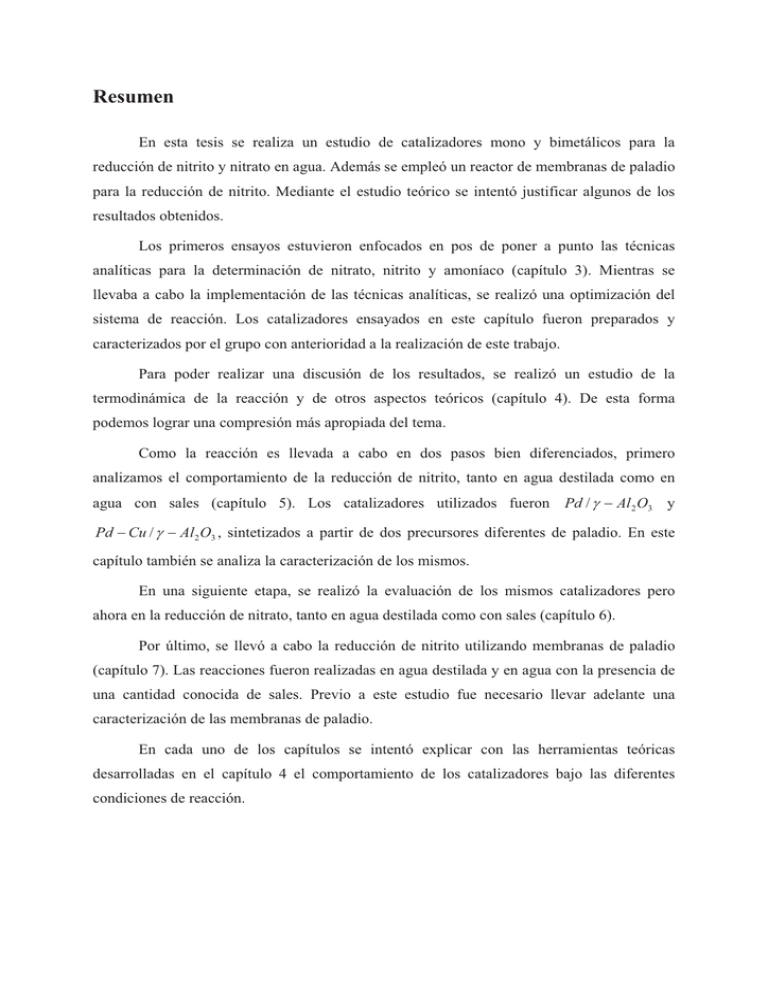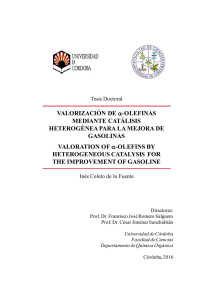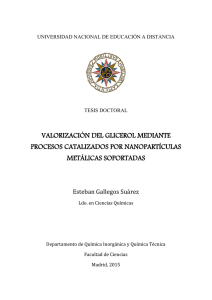Olivero-Herman-Tesis.pdf
Anuncio

Resumen En esta tesis se realiza un estudio de catalizadores mono y bimetálicos para la reducción de nitrito y nitrato en agua. Además se empleó un reactor de membranas de paladio para la reducción de nitrito. Mediante el estudio teórico se intentó justificar algunos de los resultados obtenidos. Los primeros ensayos estuvieron enfocados en pos de poner a punto las técnicas analíticas para la determinación de nitrato, nitrito y amoníaco (capítulo 3). Mientras se llevaba a cabo la implementación de las técnicas analíticas, se realizó una optimización del sistema de reacción. Los catalizadores ensayados en este capítulo fueron preparados y caracterizados por el grupo con anterioridad a la realización de este trabajo. Para poder realizar una discusión de los resultados, se realizó un estudio de la termodinámica de la reacción y de otros aspectos teóricos (capítulo 4). De esta forma podemos lograr una compresión más apropiada del tema. Como la reacción es llevada a cabo en dos pasos bien diferenciados, primero analizamos el comportamiento de la reducción de nitrito, tanto en agua destilada como en agua con sales (capítulo 5). Los catalizadores utilizados fueron Pd / ! Pd Cu / ! Al 2 O3 y Al 2 O3 , sintetizados a partir de dos precursores diferentes de paladio. En este capítulo también se analiza la caracterización de los mismos. En una siguiente etapa, se realizó la evaluación de los mismos catalizadores pero ahora en la reducción de nitrato, tanto en agua destilada como con sales (capítulo 6). Por último, se llevó a cabo la reducción de nitrito utilizando membranas de paladio (capítulo 7). Las reacciones fueron realizadas en agua destilada y en agua con la presencia de una cantidad conocida de sales. Previo a este estudio fue necesario llevar adelante una caracterización de las membranas de paladio. En cada uno de los capítulos se intentó explicar con las herramientas teóricas desarrolladas en el capítulo 4 el comportamiento de los catalizadores bajo las diferentes condiciones de reacción. Abstract In this thesis there is realized a study of monometallic and bimetallic catalysts for the reduction of nitrite and nitrate in water. Also a membrane reactor of palladium was used for reduction of nitrite. By means of the theoretical study it was attempted to justify some of the obtained results. The first tests were focused in put to calibration the analytical techniques for the determination of nitrate, nitrite and ammonia (chapter 3). While there was carried out the implementation of the analytical techniques, there was realized an optimization of the system of reaction. The catalysts tested in this chapter were prepared and characterized by the group before the beginning of this work. To be able to realize a discussion of the results, there was realized a study of the thermodynamic of the reaction and of other theoretical aspects (chapter 4). Of this form we can achieve a more appropriate compression of the topic. The reaction is carried out in two differentiated well steps; first we analyze the behavior of the reduction of nitrite, as much in distilled water as in water with salts (chapter 5). The used catalysts were Pd / ! Al 2 O3 and Pd Cu / ! Al 2 O3 , synthesized from two predecessors different from palladium. In this chapter also the characterization of the same ones is analyzed. In a following stage, there was realized the evaluation of the same catalysts but now in the reduction of nitrate, as much in distilled water as in water with salts (chapter 6). Finally, the reduction of nitrite was carried out using membranes of palladium (chapter 7). The reactions were realized in distilled water and in water with the presence a well-known quantity salts. Before this study it was necessary to take characterization of the membranes of palladium. In each of the chapters one tried to explain with the theoretical tools developed in the chapter 4 the behavior of the catalysts under the different conditions of reaction.

